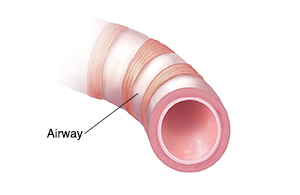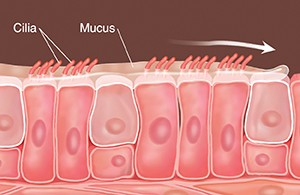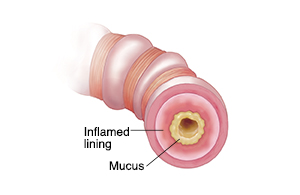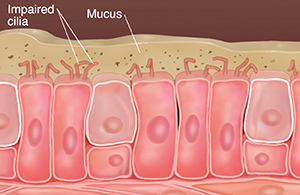What Is Acute Bronchitis?
What Is Acute Bronchitis?
Acute bronchitis is when the airways in your lungs (bronchial tubes) become red and swollen (inflamed). It is usually caused by a viral infection. But it can also occur because of a bacteria or allergen. Symptoms include a cough that produces yellow or greenish mucus and can last for days or sometimes weeks.
Lungs with bronchitis
Bronchitis often occurs with a cold or the flu virus. The airways become inflamed (red and swollen). There is a deep hacking cough from the extra mucus. Other symptoms may include:
Wheezing
Chest discomfort
Shortness of breath
Mild fever
A second infection, this time due to bacteria, may then occur. And airways irritated by allergens or smoke are more likely to get infected.
Making a diagnosis
A physical exam, health history, and certain tests help your healthcare provider make the diagnosis.
Health history
Your healthcare provider will ask you about your symptoms.
The exam
Your provider listens to your chest for signs of congestion. He or she may also check your ears, nose, and throat.
Possible tests
A sputum test for bacteria. This requires a sample of mucus from your lungs.
A nasal or throat swab. This tests to see if you have a bacterial infection.
A chest X-ray. This is done if your healthcare provider thinks you have pneumonia.
Tests to check for an underlying condition. Other tests may be done to check for things such as allergies, asthma, or COPD (chronic obstructive pulmonary disease). You may need to see a specialist for more lung function testing.
Treating a cough
The main treatment for bronchitis is easing symptoms. Avoiding smoke, allergens, and other things that trigger coughing can often help. If the infection is bacterial, you may be given antibiotics. During the illness, it's important to get plenty of sleep. To ease symptoms:
Don’t smoke. Also avoid secondhand smoke.
Use a humidifier. Or try breathing in steam from a hot shower. This may help loosen mucus.
Drink a lot of water and juice. They can soothe the throat and may help thin mucus.
Sit up or use extra pillows when in bed. This helps to lessen coughing and congestion.
Ask your provider about using medicine. Ask about using cough medicine, pain and fever medicine, or a decongestant.
Antibiotics
Most cases of bronchitis are caused by cold or flu viruses. They don’t need antibiotics to treat them, even if your mucus is thick and green or yellow. Antibiotics don’t treat viral illness and antibiotics have not been shown to have any benefit in cases of acute bronchitis. Taking antibiotics when they are not needed increases your risk of getting an infection later that is antibiotic-resistant. Antibiotics can also cause severe cases of diarrhea that require other antibiotics to treat. It is important that you accept your healthcare provider's opinion to not use antibiotics. Your provider will prescribe antibiotics if the infection is caused by bacteria. If they are prescribed:
Take all of the medicine. Take the medicine until it is used up, even if symptoms have improved. If you don’t, the bronchitis may come back.
Take the medicines as directed. For instance, some medicines should be taken with food.
Ask about side effects. Ask your provider or pharmacist what side effects are common, and what to do about them.
Follow-up care
You should see your provider again in 2 to 3 weeks. By this time, symptoms should have improved. An infection that lasts longer may mean you have a more serious problem.
Prevention
Avoid tobacco smoke. If you smoke, quit. Stay away from smoky places. Ask friends and family not to smoke around you, or in your home or car.
Get checked for allergies.
Ask your provider about getting a yearly flu shot. Also ask about pneumococcal or pneumonia shots.
Wash your hands often. This helps reduce the chance of picking up viruses that cause colds and flu.
Call your healthcare provider if:
Symptoms worsen, or you have new symptoms
Breathing problems worsen or become severe
Symptoms don’t get better within a week, or within 3 days of taking antibiotics
Inside healthy lungs
Air travels in and out of the lungs through the airways. The linings of these airways produce sticky mucus. This mucus traps particles that enter the lungs. Tiny structures called cilia then sweep the particles out of the airways.
Updated:
March 21, 2017
Reviewed By:
Blaivas, Allen J., DO,Images reviewed by StayWell medical illustration team.,Sather, Rita, RN




